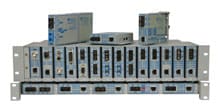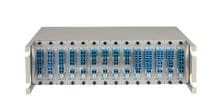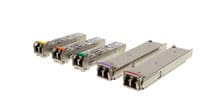- Products
- PoE Media Converters and Switches
- Ethernet & PoE Switches Product Selector
- Multi-Gigabit Ethernet and PoE Switches
- PoE PSE Commercial Switches
- PoE PSE Industrial Fiber Switches
- PoE Industrial Copper Extenders
- PoE Powered Media Converters
- PoE PSE Media Converters
- PoE Extenders & Injectors Product Selector
- Pluggable Transceivers Product Selector
- Product Lines
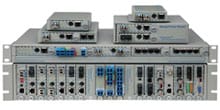
- iConverter Managed Multi-service Platform
- Copper to Fiber Media Converters
- Ethernet Media Converters
- 10 Gigabit Copper-to-Fiber
- 10/100/1000 Copper to 10 Gigabit Fiber
- 10/100/1000 Copper-to-Fiber with Integrated Management
- 10/100/1000 Industrial Copper-to-Fiber with Integrated Management
- 10/100/1000 Copper-to-Fiber with VLAN
- 10/100/1000 Dual Media Converter with VLAN
- Gigabit Copper-to-Fiber
- 10/100 Copper-to-Fiber with Integrated Management
- 10/100 Industrial Copper-to-Fiber with Integrated Management
- 10/100 Copper-to-Fiber with VLAN
- 10/100 Copper-to-Fiber
- Fast Ethernet Copper-to-Fiber
- Fast Ethernet Redundant Links
- 10Mbps Copper-to-Fiber
- 10Mbps Copper to Coax
- TDM Media Converters
- Serial Media Converters
- Ethernet Media Converters
- Fiber to Fiber Media Converters
- 10 Gigabit Fiber-to-Fiber Converter and Transponder
- 10 Gigabit Industrial Converter and Transponder
- SFP-to-SFP Fiber Converter and Transponder
- SFP-to-SFP Industrial Fiber Converter and Transponder
- Gigabit Fiber to-Fiber with 3 Rs
- 100/1000 Fiber-to-Fiber with 3 Rs
- Gigabit Fiber-to-Fiber
- Fast Ethernet Fiber-to-Fiber with 3 Rs
- Fast Ethernet Fiber-to-Fiber
- OC-3/STM-1 Fiber-to-Fiber
- OC-12/STM-4 Fiber-to-Fiber
- Carrier Ethernet Network Interface Devices
- CE 2.0 - 10G Demarcation NID
- CE 2.0 - 10G Demarcation and Aggregation NID
- CE 2.0 - 10/100/1000 Mult-port NID
- CE 2.0 - 10/100/1000 Mult-port NID with PoE
- CE 2.0 - 10/100/1000 8-Port NID
- SFP NID - Gigabit SFP NID
- microNID - 100/1000 compact NID
- CE 1.0 Service OAM - 10/100/1000 NID
- CE 1.0 Link OAM - 10/100/1000 Copper-to-Fiber NID
- CE 1.0 Link OAM - 10/100 Copper-to-Fiber NID
- CE 1.0 Link OAM - Gigabit Fiber-to-Fiber NID
- CE 1.0 Link OAM - Fast Ethernet Fiber-to-Fiber NID
- CWDM Multiplexers
- T1/E1 Multiplexers
- Ethernet Switch Modules
- Management System
- Chassis Options

- 1-Module Industrial Chassis
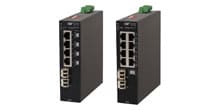
- RuggedNet Industrial Switches and Extenders
- Industrial PoE PSE Fiber Switches
- Multi-Gigabit Managed Industrial PoE+/BT Switches
- Multi-Gigabit Unmanaged Industrial PoE+/BT Switches
- 10G Managed 802.3bt PoE Switches
- 10G Unmanaged 802.3bt PoE Switches
- 10G Managed PoE+ Switches
- 10G Unmanaged PoE+ Switches
- 1G Managed PoE+ Switches
- 1G Unmanaged PoE+ Switches
- 1G Unmanaged 802.3bt PoE Switches
- 1G Managed 802.3bt PoE Switches
- Industrial Ethernet Switches
- Industrial PoE Copper Extenders
- Industrial Power Supplies

- OmniConverter Media Converter, Switches and Extenders
- PoE PSE Media Converters
- 10G Multi-Gigabit / Multi-Rate PoE Media Converter
- 10G Multi-Gigabit / Multi-Rate Media Converter
- 10/100 Multi-port PoE+ Media Converter
- 10/100 PoE+ Media Converter
- 10/100/1000 Multi-Port PoE+ Media Converter
- Industrial 10/100/1000 Multi-Port PoE+ Media Converter
- 10/100/1000 PoE+ Media Converter
- 10/100/1000 PoE++ 60W-100W Media Converter
- Industrial 10/100 Multi-port PoE+ Media Converter
- 1U Rack-Mount Shelf
- PoE PSE Compact Switches
- Multi-Gigabit Managed PoE+/BT Switches
- Multi-Gigabit Unmanaged PoE+/BT Switches
- 10G Managed 802.3bt PoE Switches
- 10G Unmanaged 802.3bt PoE Switches
- 10G Managed PoE+ Switches
- 10G Unmanaged PoE+ Switches
- 1G Managed PoE+ Switches
- 1G Unmanaged PoE+ Switches
- 1G Managed 802.3bt PoE Switches
- 1G Unmanaged 802.3bt PoE Switches
- Ethernet Switches
- PoE Copper Extenders
- Single Pair Ethernet Converters
- PoE Injectors
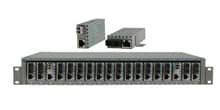
- miConverter Unmanaged Miniature Media Converters
- 10/100/1000 Copper-to-Fiber
- Industrial 10/100/1000 Copper-to-Fiber
- 10/100/1000 Ultra-Compact Copper-to-Fiber
- Gigabit Copper-to-Fiber
- 10/100/1000 Copper-to-Fiber PoE Powered
- 10/100 Copper-to-Fiber
- 10/100 Ultra-Compact Copper-to-Fiber
- 10/100 Copper-to-Fiber PoE Powered
- 18-Module Chassis
- Industrial 10/100 Copper-to-Fiber PoE Powered
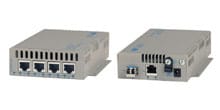
- FlexSwitch Compact Switches
- Solutions
- Company
- Support
- How to Buy
The Industrial Internet of Things (IIoT): Network Requirements and Security Considerations

The IIoT (Industrial Internet of Things) is revolutionizing the way industries operate, promising increased efficiency, productivity, and innovation. At the heart of any successful IIoT implementation is a robust and secure network infrastructure. Let's explore the key network requirements and security considerations for IIoT deployments.
Network Requirements for IIoT
The backbone of any successful IIoT deployment is a robust and reliable network. Let's break down the critical network requirements:
High Bandwidth
IIoT systems generate and transfer large volumes of data, such as high-resolution sensor readings and video streams. To handle this extensive data flow without delays, the network must support high bandwidth, ensuring smooth and efficient data transmission.
Low Latency
Many IIoT applications depend on real-time data processing and immediate responses. To meet these needs, the network must provide low latency to ensure that data is transmitted and acted upon without significant delays.
Reliability and Uptime
Continuous operation is crucial in industrial settings, where network downtime can disrupt processes and lead to significant losses. Therefore, the network should be highly reliable, with minimal downtime and robust failover systems to maintain constant operation.
Scalability
As IIoT systems expand the network must be able to scale accordingly. This means that the infrastructure should be flexible and capable of handling growing data volumes and additional devices without performance degradation.
Security
Given the vulnerabilities and potential threats to IIoT systems, the network must incorporate strong security measures, like encryption and authentication, to protect data and maintain system integrity against cyberattacks and breaches.
Network Segmentation
To enhance both security and performance, the network should be segmented to separate IIoT traffic from other types of network traffic. This segregation helps manage data flows more efficiently and reduces the risk of cross-network security issues.
Quality of Service (QoS)
Different IIoT applications have varying data transmission needs, so the network must implement QoS mechanisms. These mechanisms prioritize critical data to ensure that important information is transmitted promptly and without interruption.
Redundancy
To prevent network failures from disrupting industrial processes, the network should include redundant components and pathways. This redundancy ensures that if one part of the network fails, others can take over, maintaining continuous operation.
Interoperability
IIoT systems often involve devices and technologies from multiple vendors. Therefore, the network should support interoperability, allowing seamless communication and integration between diverse devices and systems.
Edge Computing Support
Edge computing, which involves processing data near its source, reduces latency and bandwidth usage. The network should support this capability to enable efficient local data processing and swift decision-making.
Data Management and Analytics
IIoT generates substantial amounts of data that need effective management and analysis. The network must handle these tasks efficiently, including integration with cloud or on-premises data centers for storing and analyzing information.
Environmental Adaptability
Industrial environments can be challenging, with varying temperatures and conditions. The network hardware should be rugged and capable of operating reliably under these environmental conditions.
Security Considerations for IIoT
The Industrial Internet of Things (IIoT) brings transformative benefits to industries through enhanced connectivity, real-time data analysis, and automation. However, this interconnected landscape introduces a range of security challenges that need to be addressed to safeguard critical infrastructure, protect sensitive information, and maintain operational stability.
Data Encryption
Adopting robust encryption mechanisms for data in transit and at rest is crucial to preventing unauthorized access to sensitive information. All data storage and transmission should be encrypted to guarantee that the information is secure and confidential, even if it is accessed or intercepted.
Access Control
Effective access control measures are vital for ensuring that authorized personnel can interact with IIoT systems. Implementing multi-factor authentication (MFA) and role-based access controls (RBAC) helps manage user permissions and monitor access to critical systems and data.
Network Segmentation
By segregating network traffic, you can contain potential security breaches and limit their impact. Designing the network with segments to isolate IIoT systems from other network components helps reduce the risk of cross-network attacks and improves overall security.
Regular Software Updates
Keeping software up-to-date is crucial for protecting against known vulnerabilities. Establishing a routine for applying patches and updates to IIoT devices and systems helps address security flaws and enhances protection against potential threats.
Intrusion Detection and Prevention Systems (IDPS)
Deploying intrusion detection and prevention systems (IDPS) allows for real-time identification and response to anomalous behavior, helping to mitigate risks effectively.
Device Authentication
Ensuring that only legitimate devices can connect to the network is essential for maintaining system integrity. Using device certificates or cryptographic keys to authenticate IIoT devices before granting network access helps prevent unauthorized connections.
Data Integrity
Implementing measures such as checksums and digital signatures ensures that data transmitted and stored by IIoT systems remains intact and unaltered.
Vulnerability Management
Identifying and addressing security weaknesses proactively is necessary for robust protection. Frequent penetration tests and vulnerability assessments assist in identifying possible security flaws so that countermeasures can be implemented on time.
Physical Security
Protecting physical access to IIoT devices is crucial to prevent tampering and unauthorized modifications. Ensuring that critical infrastructure is secured and accessible only to authorized personnel helps safeguard the system against physical threats.
Incident Response Plan
Having a structured plan for managing security incidents helps minimize damage and facilitates swift recovery. Creating and maintaining an incident response strategy guarantees a methodical approach to handling possible security breaches.
Compliance and Regulations
Adhering to industry-specific regulations and standards is necessary for meeting security and safety requirements. Staying informed about relevant regulations and ensuring that IIoT security practices align with legal and industry standards enhances overall compliance.
Secure Communication Protocols
Using secure communication channels protects data from interception and tampering. Implementing protocols like Transport Layer Security (TLS) for encrypted exchanges between IIoT devices and systems ensures that data remains secure during transmission.
User Training and Awareness
Users' knowledge of security best practices improves system security overall and helps prevent accidental breaches. Providing regular training on security protocols and awareness reduces the risk of human errors and social engineering attacks.
FAQs
1. Why is vulnerability management critical for IIoT systems?
Vulnerability management involves regularly assessing and addressing security weaknesses. For IIoT systems, this practice is critical because it helps identify and remediate potential security gaps, reducing the possibility of successful attacks and improving system security in general.
2. How does access control help secure IIoT systems?
Access control restricts who can interact with IIoT systems by managing user permissions and authentication. Multi-factor authentication (MFA) and role-based access controls (RBAC) are commonly used to ensure that only authorized personnel can access and manage IIoT devices and data, thereby enhancing security.
3. What is network segmentation, and how does it improve IIoT security?
Splitting a network into more manageable, isolated portions is known as network segmentation. This practice helps contain potential security breaches within specific segments, limiting their impact on other parts of the network. For IIoT, this means isolating IIoT traffic from other network components to reduce the risk of cross-network attacks.
Omnitron Systems: Your IIoT Network Partner
The Industrial Internet of Things is a game-changer for various sectors, promising unprecedented levels of efficiency, safety, and innovation. However, realizing these benefits hinges on robust network infrastructure and comprehensive security measures. By understanding and addressing the network requirements and security considerations, industries can harness the full potential of IIoT, driving future growth and success.
Omnitron Systems understands the unique challenges of IIoT networking. Our industrial-grade Ethernet switches are designed to meet the demanding requirements of IIoT environments, offering high performance, reliability, and advanced security features.
- High-bandwidth switches: Handle massive data volumes efficiently.
- Low-latency performance: Ensure real-time responsiveness for critical applications.
- Robust security: Protect your IIoT network from cyber threats.
- Scalability: Adjust to the increasing requirements of your IIoT implementation.
By partnering with Omnitron, you can build a solid foundation for your IIoT initiatives and unlock the full potential of connected devices.
Contact Omnitron Systems today to learn more about our IIoT networking solutions and how we can help you achieve your business goals. Contact us today!

